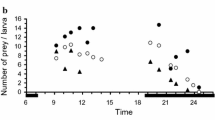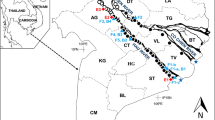Abstract
To investigate the life history and ecology of the mudskipper Periophthalmus magnuspinnatus, observations and collection were made on coastal mudflats in southern Korea. Periophthalmus magnuspinnatus was active from May to September on the mudflats, exclusively occupying rough and elevated or sloped mudflats of the seashore or the stream mouth, usually vegetated with halophilous grasses. The congeneric species, P. modestus, mainly occurred on extensive low-elevation and level mudflats with no visible vegetation. An apparent alternation of habitat use by P. modestus took place on mudflats at the stream mouth in mid-October, when P. magnuspinnatus began wintering in its burrow and P. modestus came onto the vacated mudflats to construct burrows for wintering. The active season for P. magnuspinnatus at 17°C or higher air temperature was a little shorter than that of P. modestus. Periophthalmus magnuspinnatus constructed a burrow for the entire season in the highest area of the intertidal mudflat, where they hid themselves during high tide or when frightened, whereas P. modestus were likely to use any burrow constructed by other animals or sunken places to hide. The main stomach contents of P. magnuspinnatus were crabs and gammarids. During the reproductive season from May to July, P. magnuspinnatus performed mating behaviors and constructed a spawning burrow similar to the ones known for P. modestus, except their body color turned dark and quivering body movements were observed in the mature male instead of a pink or orange body color and wiggling body movements as in P. modestus. Eggs, measuring 1.56–1.69 mm in major axis and 0.94–1.0 mm in minor axis, were laid on the ceiling and the side wall of the “J”-shaped spawning room generally known for Periophthalmus species. Young of both species started to occur on the mudflat in June.






Similar content being viewed by others
References
Atkinson RJA, Taylor AC (1991) Burrows and burrowing behaviour of fish. Symp Zool Soc Lond 63:133–155
Brillet C (1976) Structure du terrier, reproduction et comportement des jeunes chez le poisson amphibie Periophthalmus sobrinus Eggert. Terre Vie 30:465–483
Clayton DA (1993) Mudskippers. Oceanogr Mar Biol Annu Rev 31:507–577
Graham JB (1997) Air-breathing fishes. Academic Press, San Diego
Ikebe Y, Oishi T (1996) Correlation between environmental parameters and behaviour during high tides in Periophthalmus modestus. J Fish Biol 49:139–147
Ishimatsu A, Hishida Y, Takita T, Kanda T, Oikawa S, Takeda T, Khoo KH (1998) Mudskippers store air in their burrows. Nature (Lond) 391:237–238
Kobayashi T, Dotsu Y, Takita T (1971) Nest and nesting behavior of the mud skipper, Periophthalmus cantonensis in Ariake Sound. Bull Fac Fish Nagasaki Univ 32:27–40
Larson HK, Takita T (2004) Two new species of Periophthalmus (Teleostei: Gobiidae: Oxudercinae) from northern Australia, and a re-diagnosis of Periophthalmus novaeguineaensis. Beagle 20:175–185
Lee YJ, Choi Y, Ryu BS (1995) A taxonomic revision of the genus Periophthalmus (Pisces: Gobiidae) from Korea with description of a new species. Korean J Ichthyol 7:120–127
MacNae W (1968) A general account of the fauna and flora of mangrove swamps and forests in the Indo-west-Pacific region. In: Russell FS, Yonge M (eds) Advances in marine biology, vol 6. Academic Press, London, pp 73–270
Matoba M, Dotsu Y (1977) Prespawning behavior of the mud skipper Periophthalmus cantonensis in Ariake Sound. Bull Fac Fish Nagasaki Univ 43:23–33
Milward NE (1974) Studies of the taxonomy, ecology, and physiology of Queensland mudskippers. PhD thesis, University of Queensland, Brisbane
Mukherjee AK (1971a) Food-habits of water-birds of the Sundarban, 24-Parganas District, West Bengal, India. II. Herons and bitterns. J Bombay Nat Hist Soc 68:37–64
Mukherjee AK (1971b) Food-habits of water-birds of the Sundarban, 24-Parganas District, West Bengal, India. III. Egrets. J Bombay Nat Hist Soc 68:691–716
Murdy EO (1989) A taxonomic revision and cladistic analysis of the oxudercine gobies (Gobiidae: Oxudercinae). Rec Aust Mus Suppl 11:1–93
Nursall JR (1981) Behavior and habitat affecting the distribution of five species of sympatric mudskippers in Queensland. Bull Mar Sci 31:730–735
Oshiro M, Tsuhako Y, Tachihara K (2005) Habitat selection for burrow making by two species of mudskippers, Periophthalmus argentilineatus and P. modestus on the Okinawa Island, Japan. Okinawa J Biol Educ 37:9–18
Park JY (2002) Structure of the skin of an air-breathing mudskipper, Periophthalmus magnuspinnatus. J Fish Biol 60:1543–1550
Reise K (1985) Tidal flat ecology. An experimental approach to species interaction. Springer-Verlag, Berlin
Schöttle E (1931) Morphologie und Physiologie der Atmung bei wasser-, schlamm-, und landlebenden Gobiiformes. Z Wiss Zool 140:1–114
Stebbins RC, Kalk M (1961) Observations on the natural history of the mud-skipper, Periophthalmus sobrinus. Copeia 1961:18–27
Takeda T, Ishimatsu A, Oikawa S, Kanda T, Hishida Y, Khoo KH (1999) Mudskipper Periophthalmodon schlosseri can repay oxygen debts in air but not in water. J Exp Zool 284:265–270
Takita T, Agusnimar, Ali AB (1999) Distribution and habitat requirements of oxudercine gobies (Gobiidae: Oxudercinae) along the Straits of Malacca. Ichthyol Res 46:131–138
Tsuhako Y (2001) List of the studies on the oxudercine gobies (Gobiidae: Oxudercinae). Biol Mag Okinawa 39:103–139
Tytler P, Vaughan T (1983) Thermal ecology of the mudskipper Periophthalmus koelreuteri (Pallas) and Boleophthalmus boddarti (Pallas) of Kuwait Bay. J Fish Biol 23:327–337
Wang Z-Q, Yang J-Q, Tang W-Q (2006) A long-term misidentified new record species of Gobiidae from China—Periophthalmus magnuspinnatus. Acta Zootaxon Sin 31:906–910
Acknowledgments
This study was supported by a Grant-in-Aid for Scientific Research from the Ministry of Education, Science, Sport, and Culture, Japan to Dr. A. Ishimatsu of ECSER, Nagasaki University (No. 15405028). Dr. J.M. Dean (the University of South Carolina) kindly commented on the manuscript. We thank Dr. Zhang, Jie (the Institute of Zoology, Chinese Academy of Sciences) who provided information on fish distribution in China. Mr. J.M. Park and Mr. H.W. Kim of Pukyong University helped us in our field surveys.
Author information
Authors and Affiliations
Corresponding author
About this article
Cite this article
Baeck, G.W., Takita, T. & Yoon, Y.H. Lifestyle of Korean mudskipper Periophthalmus magnuspinnatus with reference to a congeneric species Periophthalmus modestus . Ichthyol Res 55, 43–52 (2008). https://doi.org/10.1007/s10228-007-0009-y
Received:
Revised:
Accepted:
Published:
Issue Date:
DOI: https://doi.org/10.1007/s10228-007-0009-y




